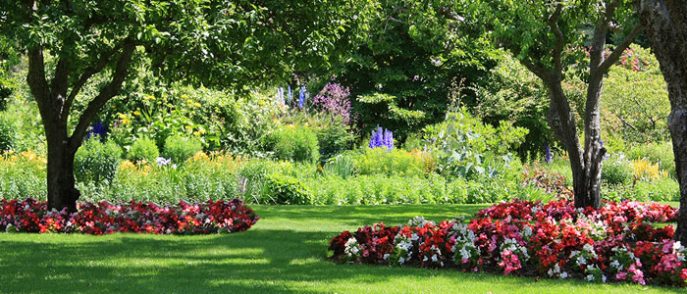It is difficult to describe the charm of roses in a few words, but the gardeners and gardeners succeeded: they called the plant "the queen of the garden." Rosa Westerland is one of many beauties decorating flowerbeds from June until frost. Flowering shrubs are resistant to excess sun, rainy weather, tolerant of lack of care.
Material Content:
Grade description
Westerland belongs to the class of scrubs - shrubby or semi-climbing roses. They appreciate this group for early and abundant flowering, relatively high winter hardiness. A rapidly growing bush reaches a height of 1.2 to 3.5 m with a width of about 1.2 m. The shoots are well-branched, grow vertically. The leaves are shiny, dark green, large.
In the southern regions, Westerland roses are grown climbing, in the middle strip - shrub.
Gardeners and breeders in the description of the variety note the large sizes of semi-double flowers (up to 10 cm), collected in a brush. A strong aroma, a rich gamut of shades - orange, amber, yellow, pink, copper, attract attention.
The color of the flowers changes depending on the weather. In the sun, the petals appear pink with a yellow base. If clouds hit, then the color becomes more saturated. A rose of this variety is often compared with a chameleon.
How to plant a plant on the site?
Shrub rose is planted in the fall, starting in mid-September. The right choice of place will help to grow a healthy, richly flowering bush. The area should be well lit or partially shaded. Between the individual plants you need to leave room for better ventilation. Also, roses should be grown at a distance from other plants.
The Westerland variety is suitable for sandy clay, humus-rich soil. Poor soil needs to be improved: add compost, well-rotted manure.On strongly acidic soils, liming is carried out. The most favorable pH values are in the range from 6 to 6.5.
Planting roses "Westerland":
- Prepare the soil in advance (2 weeks).
- Dig, align, carry out a breakdown.
- The planting hole is made a little more than the root system of the seedling.
- Pour compost to the bottom of the recess.
- Position the roots so that they are placed freely, do not break.
- The root neck should be 2 cm from the surface.
- They fill the pit with soil, compact the soil, and water the rose.
If planted in the first half of autumn, the bush will have time to grow new roots that will help the rapid development of shoots in the spring.
Outdoor Care
For the first three years, the Westerland roses grow roots more intensively, and the main stems form. During the growing season, carefully loosen the soil around the bushes. As a rule, they painlessly endure a short drought. In summer, growth improves with weekly watering, mulching with compost, monthly top dressing.
Westerland adult rose shoots can be tied up. If you plant a bush near a wall or fence, then the fence will support the branches, protect from the wind. Landscape designers and experienced gardeners recommend growing this variety without support. The tops of the shoots smoothly bend under the weight of inflorescences, which gives the plant a charming look.
In winter, roses in the middle lane need protection from severe frosts, sudden changes in temperature. In autumn, soil and compost in the form of a knoll are poured around the stems, the branches are wrapped with modern covering material. Open roses in early April.
The Westerland variety is very resistant to typical diseases of rose bushes. Aphids, ticks, beetle larvae, butterfly caterpillars can be harmful. It is recommended to carefully examine the seedlings when buying, choose healthy plants, take care of the prevention of infection with pathogens and pests.
Pruning Westerland roses after flowering
Removing wilted flowers stimulates a longer and more abundant flowering of roses. Gentle pruning is carried out at the end of October. If the bush has an arcuate shape, then the shoots are shortened by ¼ length. Remove old, not blooming, weak branches. Shoots on upright bushes should be cut to ½.
You can leave the long branches of the Westerland climbing rose for an earlier and more abundant flowering. For the winter, shoots need to be bent down, laid on a layer of spruce branches, covered with the same material or modern insulation, sprinkled with earth. Over time, to maintain a well-groomed appearance, the rose will need anti-aging pruning.
Breeding methods
Rose Westerland can be cut, root layering, divide the bush. Vegetative propagation gives the fastest results. Shoots are cut in summer from flowering bushes, buds are removed, cut into pieces with 2 or 3 leaves on each cuttings. Before planting with a clean and sharp knife, an incision is made under the lower and also above the upper kidneys. The bottom sheet is completely removed. The remaining shoots are cut to ½ length.
The ends of the cuttings are soaked in a heteroauxin solution to stimulate root formation. Planted in humus soil, deepened by 2 cm, sprinkled with wet sand by 3 cm. Cuttings are covered with cut plastic bottles from above. Spray daily.
After the appearance of the roots, new leaves will begin to grow. For winter, rooted cuttings are covered with spruce branches. The next year, young roses are transplanted to a permanent place.
You can propagate bushes of your favorite variety by division. In spring or autumn, they dig a plant, divide the rhizome with a shovel and knife into parts. Each separated part must have roots and strong stems. Planting is carried out in the same way as seedlings. Flowering young bushes will begin next year.
Use in landscape design
Rose "Westerland" looks great both in flower groups, and as a tapeworm on the lawn, lawn. You can arrange a hedge on one side or around the perimeter of the site.The variety is suitable for this purpose, as it densely branches, has resistance to disease. Roses are more often used for a bunk hedge. In the background are thuja, biota, juniper, decorative and deciduous shrubs or trees.
Vertical gardening with the Westerland rose requires support, covering material in the winter (for areas with severe frost). An arch twined with amber-orange roses is placed at the entrance to the garden and patio. There are also many options for creating a mobile rosary using containers.






























